10.1: Eggs
- Page ID
- 22045
\( \newcommand{\vecs}[1]{\overset { \scriptstyle \rightharpoonup} {\mathbf{#1}} } \)
\( \newcommand{\vecd}[1]{\overset{-\!-\!\rightharpoonup}{\vphantom{a}\smash {#1}}} \)
\( \newcommand{\id}{\mathrm{id}}\) \( \newcommand{\Span}{\mathrm{span}}\)
( \newcommand{\kernel}{\mathrm{null}\,}\) \( \newcommand{\range}{\mathrm{range}\,}\)
\( \newcommand{\RealPart}{\mathrm{Re}}\) \( \newcommand{\ImaginaryPart}{\mathrm{Im}}\)
\( \newcommand{\Argument}{\mathrm{Arg}}\) \( \newcommand{\norm}[1]{\| #1 \|}\)
\( \newcommand{\inner}[2]{\langle #1, #2 \rangle}\)
\( \newcommand{\Span}{\mathrm{span}}\)
\( \newcommand{\id}{\mathrm{id}}\)
\( \newcommand{\Span}{\mathrm{span}}\)
\( \newcommand{\kernel}{\mathrm{null}\,}\)
\( \newcommand{\range}{\mathrm{range}\,}\)
\( \newcommand{\RealPart}{\mathrm{Re}}\)
\( \newcommand{\ImaginaryPart}{\mathrm{Im}}\)
\( \newcommand{\Argument}{\mathrm{Arg}}\)
\( \newcommand{\norm}[1]{\| #1 \|}\)
\( \newcommand{\inner}[2]{\langle #1, #2 \rangle}\)
\( \newcommand{\Span}{\mathrm{span}}\) \( \newcommand{\AA}{\unicode[.8,0]{x212B}}\)
\( \newcommand{\vectorA}[1]{\vec{#1}} % arrow\)
\( \newcommand{\vectorAt}[1]{\vec{\text{#1}}} % arrow\)
\( \newcommand{\vectorB}[1]{\overset { \scriptstyle \rightharpoonup} {\mathbf{#1}} } \)
\( \newcommand{\vectorC}[1]{\textbf{#1}} \)
\( \newcommand{\vectorD}[1]{\overrightarrow{#1}} \)
\( \newcommand{\vectorDt}[1]{\overrightarrow{\text{#1}}} \)
\( \newcommand{\vectE}[1]{\overset{-\!-\!\rightharpoonup}{\vphantom{a}\smash{\mathbf {#1}}}} \)
\( \newcommand{\vecs}[1]{\overset { \scriptstyle \rightharpoonup} {\mathbf{#1}} } \)
\( \newcommand{\vecd}[1]{\overset{-\!-\!\rightharpoonup}{\vphantom{a}\smash {#1}}} \)
\(\newcommand{\avec}{\mathbf a}\) \(\newcommand{\bvec}{\mathbf b}\) \(\newcommand{\cvec}{\mathbf c}\) \(\newcommand{\dvec}{\mathbf d}\) \(\newcommand{\dtil}{\widetilde{\mathbf d}}\) \(\newcommand{\evec}{\mathbf e}\) \(\newcommand{\fvec}{\mathbf f}\) \(\newcommand{\nvec}{\mathbf n}\) \(\newcommand{\pvec}{\mathbf p}\) \(\newcommand{\qvec}{\mathbf q}\) \(\newcommand{\svec}{\mathbf s}\) \(\newcommand{\tvec}{\mathbf t}\) \(\newcommand{\uvec}{\mathbf u}\) \(\newcommand{\vvec}{\mathbf v}\) \(\newcommand{\wvec}{\mathbf w}\) \(\newcommand{\xvec}{\mathbf x}\) \(\newcommand{\yvec}{\mathbf y}\) \(\newcommand{\zvec}{\mathbf z}\) \(\newcommand{\rvec}{\mathbf r}\) \(\newcommand{\mvec}{\mathbf m}\) \(\newcommand{\zerovec}{\mathbf 0}\) \(\newcommand{\onevec}{\mathbf 1}\) \(\newcommand{\real}{\mathbb R}\) \(\newcommand{\twovec}[2]{\left[\begin{array}{r}#1 \\ #2 \end{array}\right]}\) \(\newcommand{\ctwovec}[2]{\left[\begin{array}{c}#1 \\ #2 \end{array}\right]}\) \(\newcommand{\threevec}[3]{\left[\begin{array}{r}#1 \\ #2 \\ #3 \end{array}\right]}\) \(\newcommand{\cthreevec}[3]{\left[\begin{array}{c}#1 \\ #2 \\ #3 \end{array}\right]}\) \(\newcommand{\fourvec}[4]{\left[\begin{array}{r}#1 \\ #2 \\ #3 \\ #4 \end{array}\right]}\) \(\newcommand{\cfourvec}[4]{\left[\begin{array}{c}#1 \\ #2 \\ #3 \\ #4 \end{array}\right]}\) \(\newcommand{\fivevec}[5]{\left[\begin{array}{r}#1 \\ #2 \\ #3 \\ #4 \\ #5 \\ \end{array}\right]}\) \(\newcommand{\cfivevec}[5]{\left[\begin{array}{c}#1 \\ #2 \\ #3 \\ #4 \\ #5 \\ \end{array}\right]}\) \(\newcommand{\mattwo}[4]{\left[\begin{array}{rr}#1 \amp #2 \\ #3 \amp #4 \\ \end{array}\right]}\) \(\newcommand{\laspan}[1]{\text{Span}\{#1\}}\) \(\newcommand{\bcal}{\cal B}\) \(\newcommand{\ccal}{\cal C}\) \(\newcommand{\scal}{\cal S}\) \(\newcommand{\wcal}{\cal W}\) \(\newcommand{\ecal}{\cal E}\) \(\newcommand{\coords}[2]{\left\{#1\right\}_{#2}}\) \(\newcommand{\gray}[1]{\color{gray}{#1}}\) \(\newcommand{\lgray}[1]{\color{lightgray}{#1}}\) \(\newcommand{\rank}{\operatorname{rank}}\) \(\newcommand{\row}{\text{Row}}\) \(\newcommand{\col}{\text{Col}}\) \(\renewcommand{\row}{\text{Row}}\) \(\newcommand{\nul}{\text{Nul}}\) \(\newcommand{\var}{\text{Var}}\) \(\newcommand{\corr}{\text{corr}}\) \(\newcommand{\len}[1]{\left|#1\right|}\) \(\newcommand{\bbar}{\overline{\bvec}}\) \(\newcommand{\bhat}{\widehat{\bvec}}\) \(\newcommand{\bperp}{\bvec^\perp}\) \(\newcommand{\xhat}{\widehat{\xvec}}\) \(\newcommand{\vhat}{\widehat{\vvec}}\) \(\newcommand{\uhat}{\widehat{\uvec}}\) \(\newcommand{\what}{\widehat{\wvec}}\) \(\newcommand{\Sighat}{\widehat{\Sigma}}\) \(\newcommand{\lt}{<}\) \(\newcommand{\gt}{>}\) \(\newcommand{\amp}{&}\) \(\definecolor{fillinmathshade}{gray}{0.9}\)Nature designed eggs as the food source for developing chicks. Eggs, particularly chicken eggs, are also an excellent food for humans because of their high protein content, low cost and ready availability. They are extremely versatile and are used throughout the kitchen, either served alone or as ingredients in a prepared dish. Eggs are used to provide texture, flavor, structure, moisture and nutrition in everything from soups and sauces to breads and pastries.
Egg dishes are, of course, most often associated with the meals breakfast and brunch. But food service operations must offer a variety of breakfast options to appeal to a wide range of consumers. Breakfast cookery is often one of the first line positions a new cook will be offered. This important duty requires speed, timing and precision and can help an apprentice or beginning cook develop organized, efficient work habits.
This chapter discusses cooking methods used for eggs as well as breakfast meats, griddlecakes, crepes, cereals and the beverages coffee and tea.
Egg Composition
The primary parts of an egg are the shell, yolk and albumen.
The shell, composed of calcium carbonate, is the outermost covering of the egg. It prevents microbes from entering and moisture from escaping, and protects the egg during handling and transport. The breed of the hen determines shell color; for chickens, it can range from bright white to brown. Shell color has no effect on quality, flavor or nutrition:
The yolk is the yellow portion of the egg. It constitutes just over one -third of the egg and contains three -fourths of the calories, most of the minerals and vitamins and all the fat. The yolk also contains lecithin, the compound responsible for emulsification in products such as hollandaise sauce and mayonnaise . Egg yolk solidifies (coagulates) at temperatures between 149°F and 158°F (65°C and 70°C). Although the color of a yolk may vary depending on the hen's feed, color does not affect quality or nutritional content.
The albumen is the clear portion of the egg and referred to as the egg white. It constitutes about two-thirds of the egg and contains more than half of the protein and riboflavin. Egg white coagulates, becoming firm and opaque, at temperatures between 144°F and 149°F (62°C and 65°C).
Eggs are sold in Jumbo, Extra Large, Large, Medium, Small and Peewee sizes, as determined by weight per dozen. See Figure 21.2. Food service operations generally use Large eggs, which weigh 24 ounces per dozen. Other sizes are based on plus or minus 3 ounces per dozen; Medium eggs weigh 21 ounces per dozen while Extra Large eggs weigh 27 ounces per dozen.
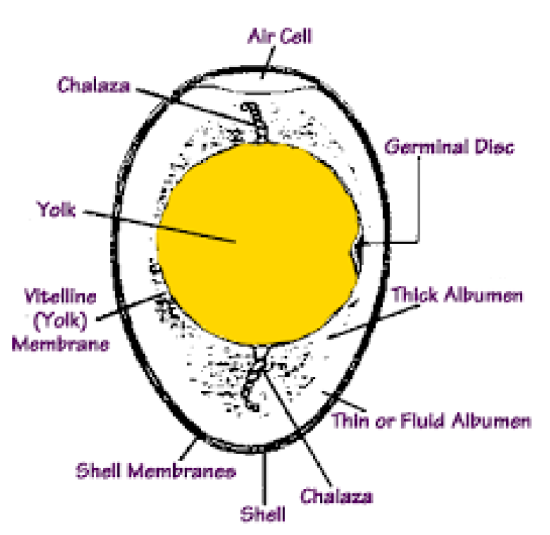
extension.illinois.edu
The yolk is the yellow portion of the egg. It constitutes just over one -third of the egg and contains three -fourths of the calories, most of the minerals and vitamins and all the fat. The yolk also contains lecithin, the compound responsible for emulsification in products such as hollandaise sauce and mayonnaise. Egg yolk solidifies (coagulates) at temperatures between 149°F and 158°F (65°C and 70°C). Although the color of a yolk may vary depending on the hen's feed, color does not affect quality or nutritional content. The albumen is the clear portion of the egg and is often referred to as the egg white. It constitutes about two-thirds of the egg and contains more than half of the protein and riboflavin. Egg white coagulates, becoming firm and opaque, at temperatures between 144°F and 149°F.
Grading
Eggs are graded by the USDA or a state agency following USDA guidelines. The grade AA, A, or B is given to an egg based on interior and exterior quality, not size. Grade has no effect on nutritional values.
Storage
Improper handling quickly diminishes egg quality. Eggs should be stored at temperatures below 45°F (7°C) and at a relative humidity of 70 to 80 percent. Eggs will age more during one day at room temperature than they will during one week under proper refrigeration. As eggs age, the white becomes thinner and the yolk becomes flatter. Although this will change the appearance of poached or fried eggs, age has little effect on nutrition or behavior during cooking procedures. Older eggs, however, should be used for hard cooking, as the shells are easier to remove than those on fresh eggs are.
Cartons of fresh, uncooked eggs will keep for at least four to five weeks beyond the pack date if properly refrigerated. Hard-cooked eggs left in their shells and refrigerated should be used within one week. Store eggs away from strongly flavored foods to reduce odor absorption. Rotate egg stock to maintain freshness. Do not use dirty, cracked or broken eggs, as they may contain bacteria or other contaminants. Frozen eggs should be thawed in the refrigerator and used only in dishes that will be thoroughly cooked, such as baked products.
Other Eggs
When most people refer to an "egg," they mean a chicken's egg. However, other eggs are sometimes used in the kitchen:
- Bantam egg: The egg from a breed of small chicken; it is about half the size of a regular chicken egg and has the same characteristics.
- Duck egg: An egg with an off-white shell and a richer flavor and higher fat content than a chicken's egg; when it is boiled, the white turns bluish and the yolk turns red-orange.
- Goose egg: A white-shelled egg that is four to five times as large as a chicken egg; it also has a somewhat richer flavor.
- Guinea fowl egg: An egg with an ivory shell flecked with brown; its flavor is more delicate than that of a chicken egg.
- Gull egg: An egg whose shell is covered with light to dark brown blotches; it comes in various small sizes and has a slightly fishy flavor.
- Ostrich egg: An egg that is 20 times as large as a chicken egg and has a thick, ivory-colored shell; its flavor is similar to that of a chicken egg.
- Partridge egg: A small egg with a white, buff or olive shell; it has a mild flavor.
- Quail egg: A small egg with a speckled brown shell; it has a rich flavor.
- Turkey egg: A large egg with a brown shell; it has a delicate flavor.
- Turtle egg: A reptile's egg with a soft shell that is buff or speckled; it has a mild, rich flavor.
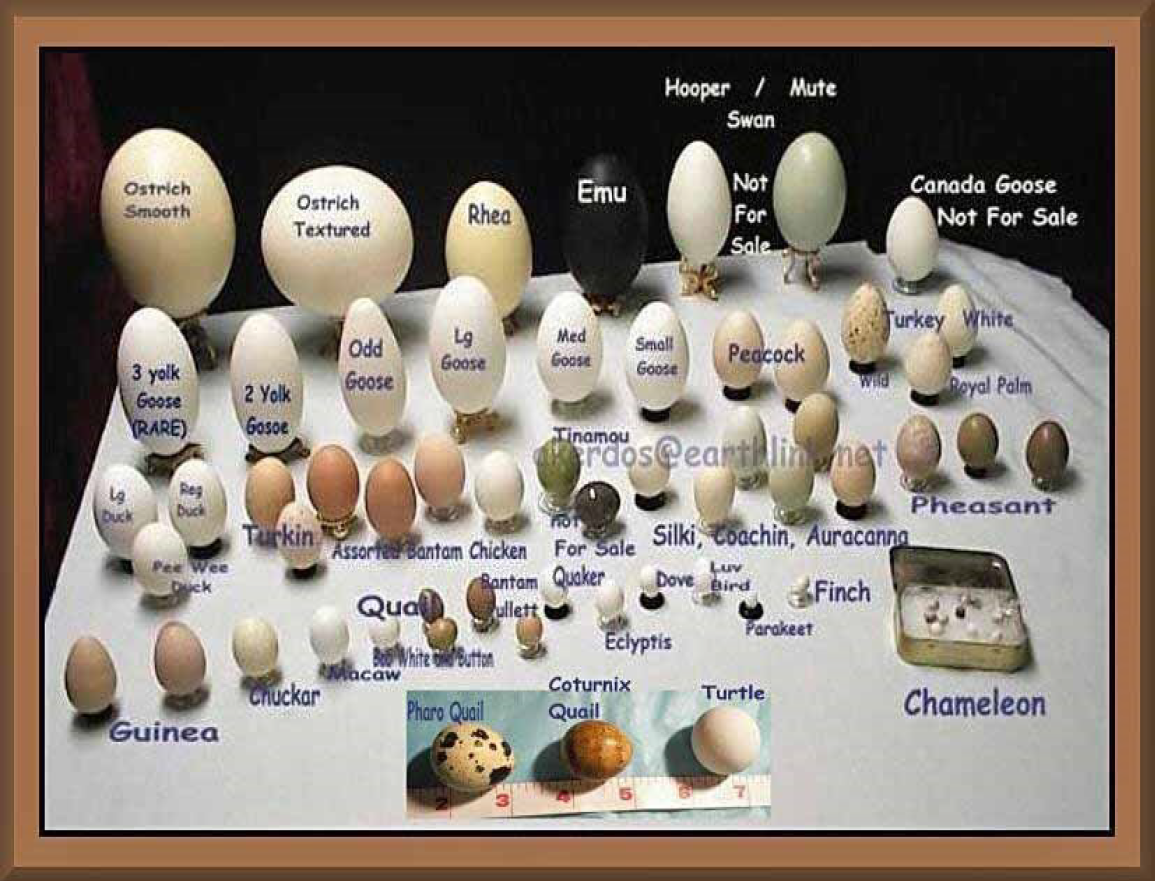
Egg Varieties. pysankybasics.com
Sanitation
Eggs are a potentially hazardous food. Rich in protein, they are an excellent breeding ground for bacteria. Salmonella is of particular concern with eggs and egg products because the bacteria are commonly found in a chicken's intestinal tract. Although shells are cleaned at packinghouses, some bacteria may remain. Therefore, to prevent contamination, it is best to avoid mixing a shell with the liquid egg.
Inadequately cooking or improperly storing eggs may lead to food-borne illnesses. USDA guidelines indicate that pasteurization is achieved when the whole egg stays at a temperature of 140°F (60°C) for Y/2 minutes. Hold egg dishes below 40°F (4°C) or above 140°F (60°C). Never leave an egg dish at room temperature for more than one hour, including preparation and service time. Never reuse a container after it has held raw eggs without thoroughly cleaning and sanitizing it.
Egg Products
Food service operations often want the convenience of buying eggs out of the shell in the exact form needed: whole eggs, yolks only or whites only. These processed items are called egg products and are subject to strict pasteurization standards and USDA inspections. Egg products can be frozen, refrigerated or dried. Precooked, pre-portioned, and blended egg products are also available.
Nutrition
Eggs contain vitamins A, D, E and K, and the B-complex vitamins. They are rich in minerals and contain less cholesterol now than previously. Research indicates that the cholesterol in whole eggs does not affect serum cholesterol as much as was once feared. In fact, the American Heart Association now suggests that it is acceptable to consume up to four egg yolks per week as part of a balanced diet. Egg whites do not contain cholesterol and are often added to egg dishes such as omelets to reduce total fat content.
Dry Heating Cooking
Baking
Shirred Eggs
Baked eggs, also referred to as shirred eggs, are normally prepared in individual ramekins or baking dishes. The ramekins can be lined or partially filled with ingredients such as bread, ham, creamed spinach or artichokes. The eggs are often topped with grated cheese, fresh herbs or a sauce. When properly cooked, the egg whites should be set while the yolks are soft and creamy.
Preparation
- Coat each ramekin with melted butter. Add flavoring ingredients as desired.
- Break one or two eggs into each ramekin. Do not break the yolks. Season with salt and pepper.
- Bake the eggs until the white is firm, approximately 12- 15 minutes. Approximately 3- 5 minutes before the eggs are done, add cream or top the eggs with grated cheese , diced ham, fresh herbs or other ingredients as desired.
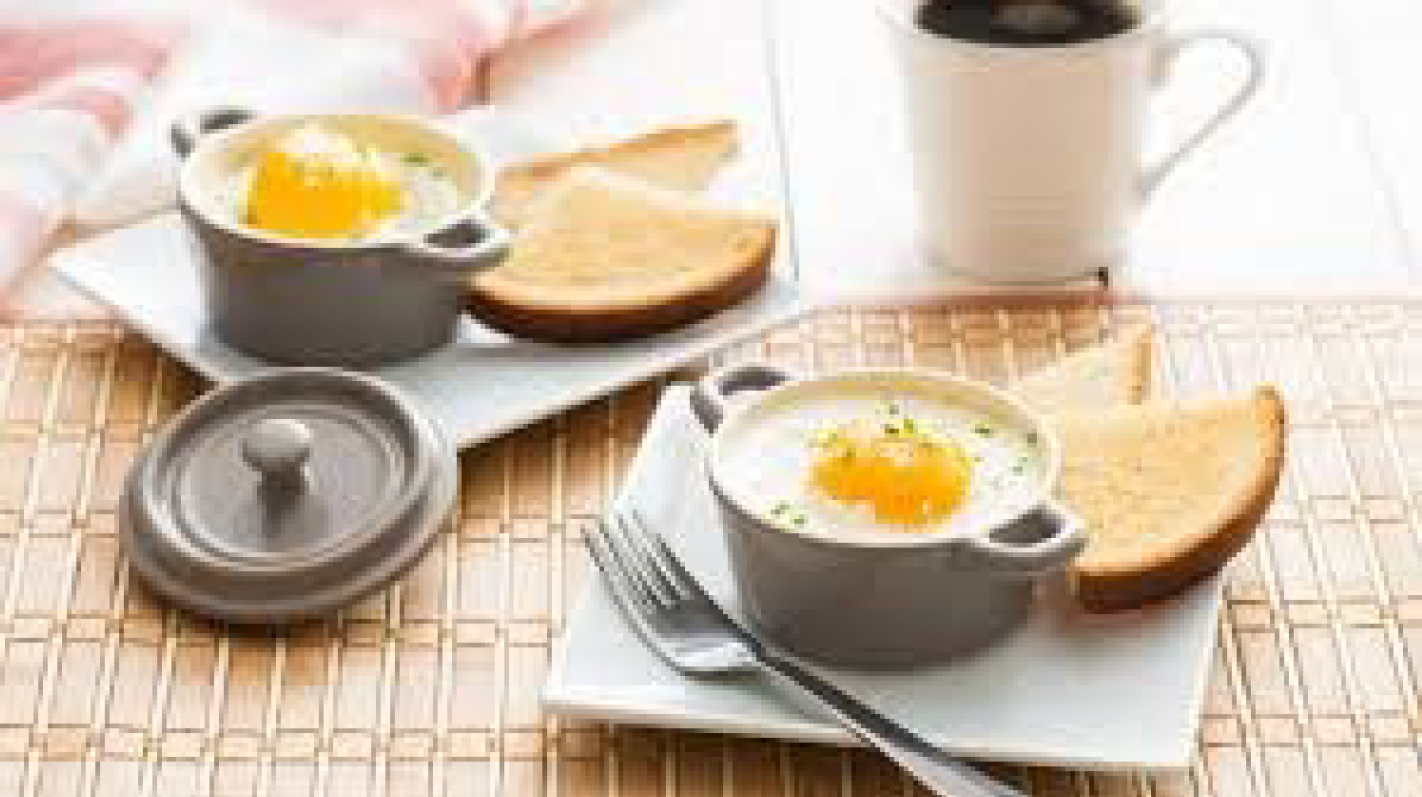
Shirred Eggs. eggs.ca
Sauteing
Scrambled Eggs
Scrambled eggs are eggs whisked with seasonings and then sautéed. They must be stirred nearly constantly during cooking. The finished eggs should be light and fluffy with a tender, creamy texture. A small amount of milk or cream may be added to the eggs to provide a more delicate finished product. Overcooking or cooking at too high a temperature causes the eggs to become tough and rubbery.
Scrambled eggs are often flavored by sautéing other foods (for example), onions, mushrooms or diced ham) in the pan before adding the eggs or by adding other foods (for example, grated cheeses or herbs) to the eggs just before cooking is complete. Suggested additions include finely diced bell peppers, onions, mush rooms, zucchini or tomatoes; cottage cheese or any variety of shredded firm cheese; crumbled bacon; diced ham, turkey or beef; bits of smoked salmon, cooked shrimp or cooked sausage; and fresh herbs.
Scrambled eggs can also be prepared using only egg whites. Because all of an egg's fat is stored in the yolk, no-yolk scrambled egg dishes are lower in fat, cholesterol and calories. Water or nonfat milk can be used in place of whole milk or cream to further reduce the fat and calorie content of the finished dish. Re member that egg whites coagulate at a lower temperature than yolks, so adjust the cooking time and temperature accordingly.
Preparation
- Break the eggs into a mixing bowl. Season lightly with salt and pepper. Add 1 scant tablespoon (12 milliliters) milk or cream per egg and whisk everything together.
- Heat a sauté pan, add clarified butter or oil and heat until the fat begins to sizzle.
- Sauté any additional ingredients in the hot fat.
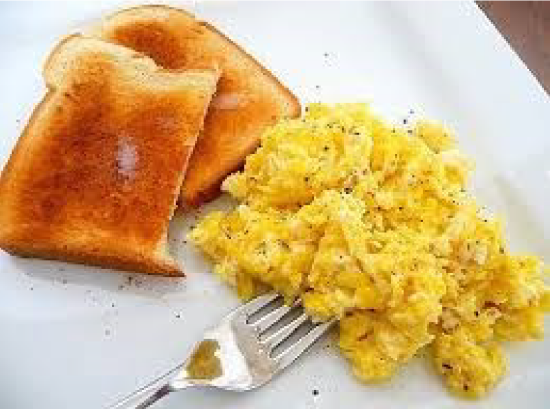
Scrambled eggs and Toast. browneyedbaker.com
Frittatas
Frittatas are essentially open -faced omelets of Spanish-Italian heritage. They may be cooked in small pans as individual portions, or in large pans, and then cut into wedges for service. A relatively large amount of hearty ingredients is mixed directly into the eggs. The eggs are first cooked on the stovetop, and then the pan is transferred to an oven or placed under a salamander or broiler to finish cooking.
Preparation
- Fully cook any meats and blanch or otherwise prepare any vegetables that will be incorporated into the frittata .
- Heat a sauté pan and add clarified butter.
- Whisk the eggs, flavorings and any other ingredients together; pour into the pan.
- Stir gently until the eggs begin to set. Gently lift cooked egg at the edge of the frittata so that raw egg can run underneath. Continue cooking until the eggs are almost set.
- Place the pan in a hot oven or underneath a salamander or broiler to finish cooking and lightly brown the top.
- Slide the finished frittata out of the pan onto a serving platter.
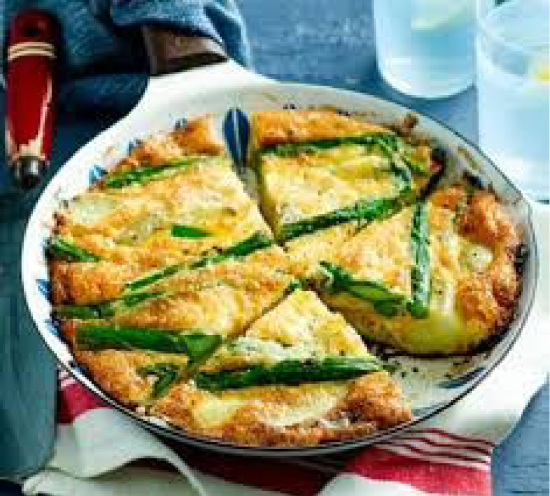
Vegetable Frittata. bbcgoodfood.com
Pan-Frying
Pan-fried eggs are commonly referred to as sunny side up or over easy, over medium or over hard. These are visibly different products produced with proper timing and technique. Very fresh eggs are best for pan-frying, as the yolk holds its shape better and the white spreads less.
Sunny-side-up eggs are not turned during cooking; their yellow yolks remain visible. They should be cooked over medium -low heat long enough to firm the whites and partially firm the yolks: approximately 4 minutes if cooked on a 250°F (120°C) cooking surface.
For "over" eggs, the egg is partially cooked on one side, then gently flipped, and cooked on the other side until done. The egg white should be firm, and its edges should not be brown. The yolk should never be broken regardless of the degree of doneness. Not only is a broken yolk unattractive, but the spilled yolk will coagulate on contact with the hot pan, making it difficult to serve.
For over-easy eggs, the yolk should remain very runny; on a 250°F (120°C) cooking surface, the egg should cook for about 3 minutes on the first side and 2 minutes on the other. Over-medium eggs should be cooked slightly longer, until the yolk is partially set. For over-hard eggs, the yolk should be completely cooked.
Preparation
- Select a sauté pan just large enough to accommodate the number of eggs being cooked. An 8-inch in diameter pan is appropriate for up to three eggs.
- Add a small amount of clarified butter and heat until the fat just begins to sizzle.
- Carefully break the eggs into the pan.
- Continue cooking over medium-low heat until the eggs reach the appropriate degree of firmness. Sunny-side-up eggs are not flipped during cooking; "over" eggs are flipped once during cooking.
- When done, gently flip the "over" eggs once again so that the first side is up, then gently slide the cooked eggs out of the pan onto the serving plate.
Basted eggs are a variation of sunny-side-up eggs. Basted eggs are cooked over low heat with the hot butter from the pan spooned over them as they cook. Another version of basted eggs is made by adding 1 to 2 teaspoons (5 to 10 milliliters) water to the sauté pan and then covering the pan. The steam cooks the top of the eggs.
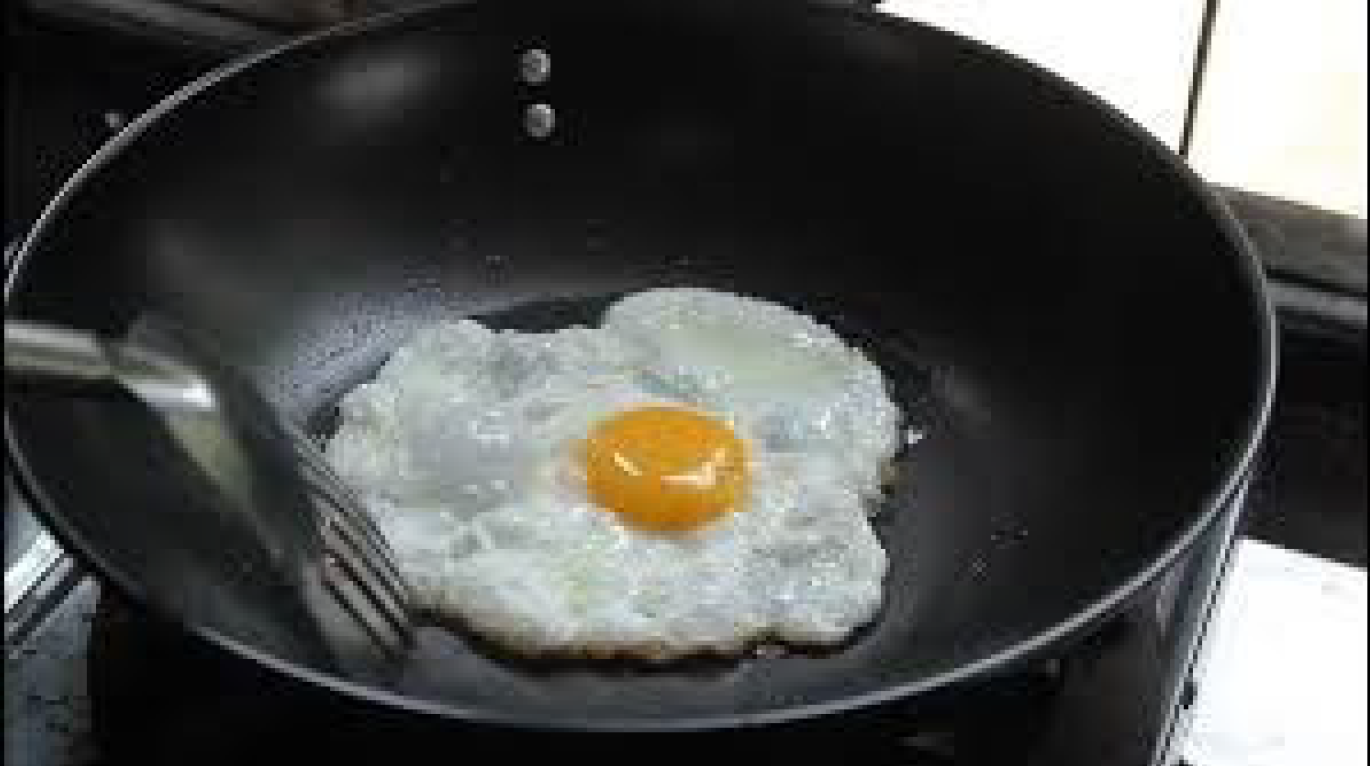
Pan-Fried Eggs. shutterstock.com
Moist Heat Cooking
In-Shell Cooking (Simmering)
The difference between soft-cooked eggs (also called soft-boiled) and hard-cooked eggs (also called hard-boiled) is time. Both styles refer to eggs cooked in their shell in hot water. Despite the word boiled in their names, eggs cooked in the shell should never be boiled. Boiling toughens eggs and causes discoloration. Instead, the eggs should be simmered. Soft-cooked eggs are usually simmered for 3 to 5 minutes; hard-cooked eggs may be simmered for as long as 12 to 15 minutes. Sometimes it is difficult to remove the shell from very fresh eggs. Eggs that are a few days old are better for cooking in the shell.
Preparation
- Fill a saucepan or stockpot with sufficient water to cover the eggs. Bring the water to a simmer.
- Carefully lower each egg into the simmering water.
- Simmer uncovered for 3 to 5 minutes (soft cooking), depending on the firmness desired.
- Lift each egg out of the water with a slotted spoon or spider.
- Crack the large end of the shell carefully and serve immediately.
- When the eggs are cool enough to handle, peel them and use as desired or cover and refrigerate for up to 5 days.
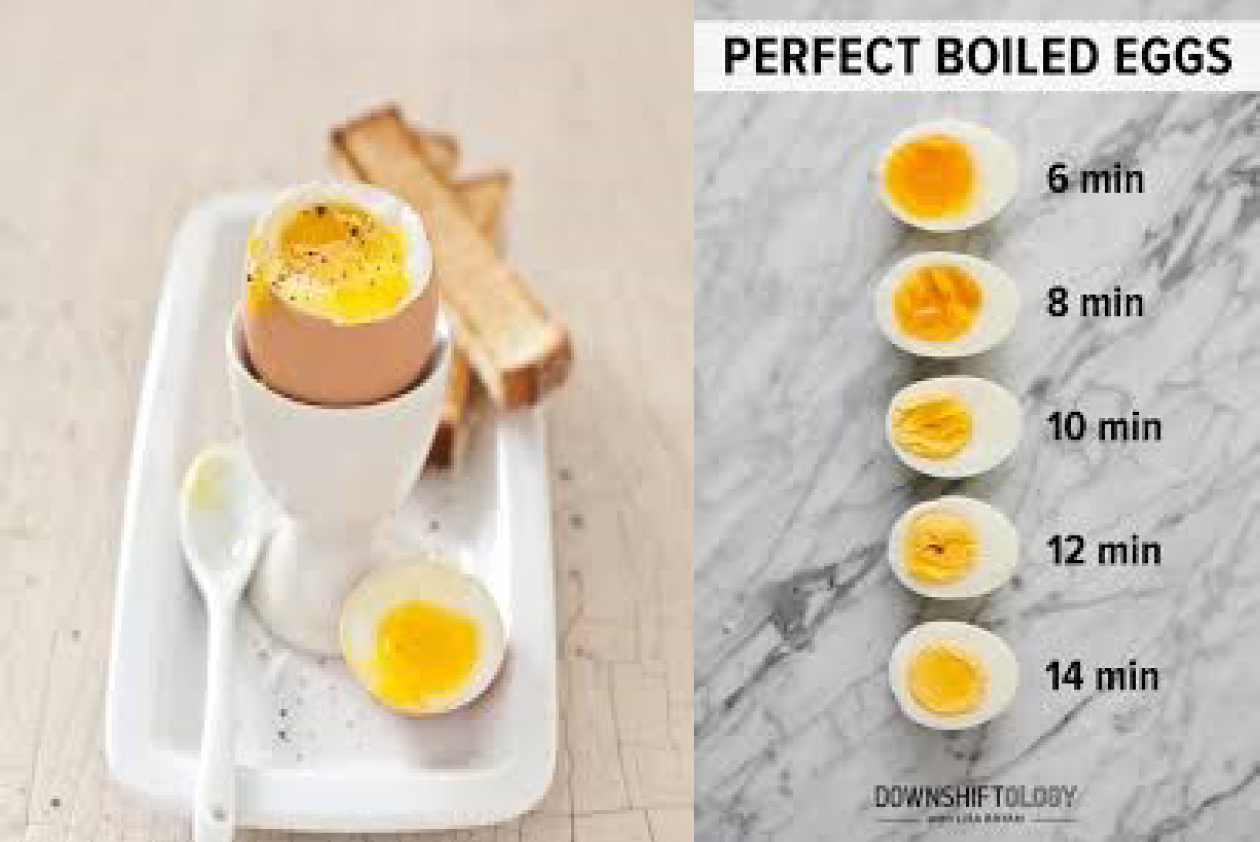
Soft boiled egg. cooksillustrated.com downshiftology.com
Poaching
Eggs that are to be poached should always be very fresh. They should also be kept very cold until used, as cold egg whites stay together better when dropped into hot water. The water for poaching eggs should be held at approximately 200°F (90°C), a gentle simmer. Poached eggs should be soft and moist; the whites should be firm enough to encase the yolk completely, but the yolk should still be runny.
Some chefs add salt to the poaching water for flavor; others believe that the salt causes the egg whites to separate. To help the egg whites cling together, add 2-tablespoons (30 milliliters) white vinegar per quart (liter) of water.
Preparation
- Fill a saucepan or stockpot with at least 3 inches (7.S centimeters) water. Add salt and vinegar if desired. Bring the water to a simmer and hold at a temperature of approximately 200°F (90°C).
- One at a time, crack the eggs into a small ramekin or cup. If a piece of shell falls into the egg, it should be removed; if the yolk breaks, the egg can be set aside for some other use.
- Gently slide each egg into the simmering water and cook for 3 to 5 minutes.
- Lift the poached egg out of the water with a slotted spoon. Trim any ragged edges with a paring knife. Serve immediately.
For quantity service, eggs can be poached in advance and held for up to one day. To do so, cook the eggs as described. As each egg is removed from the hot water, set it in a hotel pan filled with ice water to stop the cooking process. The eggs can then be stored in the ice water until needed. For banquet -style service, all the eggs can be reheated at once by placing the entire pan on the stove top. Alternatively, the eggs can be reheated one or two at a time by placing them in a pan of barely simmering water until they are hot.
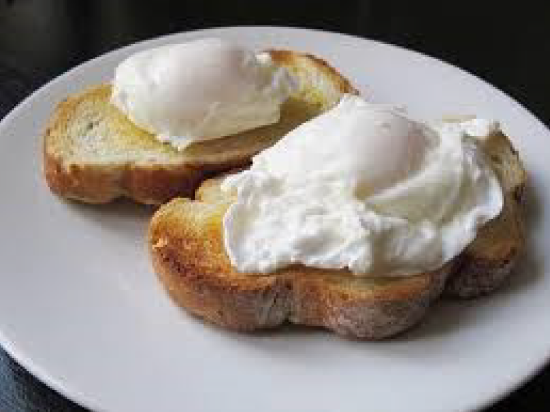
Poached Eggs on Toast. myrecipes.com


